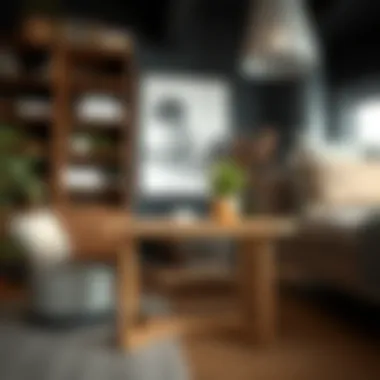Exploring Small Craft Tables: Design and Functionality


Intro
Small craft tables have carved a unique niche in the realm of home and design. These compact pieces of furniture serve not just as a surface for creativity but also play an integral role in the aesthetics of a room. Whether one is a skilled artisan or a casual crafter, the significance of a well-designed craft table cannot be overstated. In today’s fast-paced world, where working from home has become more common, the need for these multifunctional pieces has surged.
When delving into the aspects of design, functionality, and style, small craft tables emerge as a reflection of their owner’s personality. The craftsmanship behind these tables often integrates a mix of innovative concepts and traditional approaches. As we explore this dynamic field, we will examine contemporary trends, delve into the essential characteristics that define versatility, and provide insightful tips on choosing the ideal craft table for various needs. This guide aims to elevate not only your understanding of these tables but also your ability to integrate them seamlessly into your living space.
Design Trends
Craft tables are no longer made solely for utility; they now embody a broader design philosophy that harmonizes with various interior styles. From minimalist aesthetics to rustic charm, the options are plentiful, allowing craft enthusiasts to select a table that resonates with their style.
Current Trends in Furniture Styles
The popularity of small craft tables has spurred several design trends that stand out in the modern market. Here are some trends worth noting:
- Minimalism: Clean lines, neutral colors, and functional designs dominate minimalistic tables. The idea is to keep things uncluttered, allowing for focus on the crafting process.
- Industrial: Many homeowners are embracing the rugged look of industrial tables, featuring raw materials like metal and reclaimed wood, which add character and durability.
- Scandinavian Influences: Known for their simplicity and elegance, Scandinavian designs prioritize practicality. A craft table embodying this style often showcases light woods and subtle colors, making them versatile and cozy.
- Vintage Revival: A resurgence in vintage styles means that many tables now incorporate retro elements. Think distressed finishes and ornate details that add a touch of nostalgia.
How to Incorporate Trends into Your Space
Incorporating a small craft table into your home might seem daunting, but it doesn't need to be. Here are some tips:
- Match Your Style: Choose a table that complements the existing décor. If your space is adorned with vintage pieces, pick a table that reflects that style.
- Functional Zones: Define a craft zone in your home. Consider placing your craft table near good natural light and accessible storage.
- Personal Touches: Decorate around your table with art or items that inspire, creating an atmosphere that stimulates creativity.
- Adaptability is Key: Look for tables that can easily move or change function, allowing them to fit into different spaces as your needs evolve.
Craft tables function as more than just a workspace; they act as catalysts for creativity and expression, enhancing the very nature of the craft itself.
Buying Guides
A craft table is a significant investment, and ensuring you make the right choice is essential for maximizing your creative output.
Choosing the Right Furniture for Different Rooms
When selecting a small craft table, it's important to consider the room's layout and purpose. Here’s how to match tables to various environments:
- Studios: A large, sturdy table is crucial in a studio for enough workspace and material storage.
- Living Rooms: Opt for a stylish, multifunctional table that can double as a decorative element and a working surface, perhaps with storage underneath or a convertible design.
- Kitchens: A compact table that can serve as an additional prep space would work well, especially if you have a smaller kitchen.
Tips for Assessing Quality and Value
Not all tables are built the same. Thus, consider these pointers to ensure quality:
- Material Matters: Inspect the type of materials used in construction. Solid wood, for instance, offers durability over particle board.
- Joinery: Examine how the pieces fit together, ensuring strong joints that will withstand the test of time.
- Finish Quality: Check the surface finish—smooth, even surfaces are essential for crafting. Avoid tables with rough patches or blemishes.
- Size and Shape: A table must not only fit the space but also facilitate movement around it. Consider both the table dimensions and enough breathing space.
Ultimately, a well-rounded small craft table should cater to your personal style and practical needs, enhancing both your creative experience and your living space.
Preamble to Small Craft Tables
Craft tables play a pivotal role in the world of DIY and artistic endeavors. Their importance goes beyond mere function; they symbolize a commitment to creativity and organization in the workspace. In an increasingly digital world, many are turning back to hands-on pursuits, making the appeal of crafting stronger than ever. Thus, understanding the concept of small craft tables is essential for anyone who indulges in activities such as scrapbooking, drawing, or even knitting.
Small craft tables are more than just surfaces to work on; they embody a blend of design, functionality, and style. These tables are often crafted with functionality at their core, ensuring that they serve the multifaceted needs of artists and hobbyists alike. When designed with thoughtful elements, they can enhance the productivity of the crafter, allowing for a smoother workflow and enabling individuals to focus more on their craft rather than the chaos of clutter.
Defining Small Craft Tables
To understand what a small craft table is, we first look at its fundamental characteristics. A small craft table is typically a compact workspace designed primarily for various crafting activities. Unlike standard tables, these are specifically engineered to accommodate tools, materials, and personal belongings that are essential in creative projects. They vary in size, but generally, they aim to occupy limited space while providing ample usability.
The defining features often include:
- Surface Area: A practical tabletop size suitable for crafting, whether it be scrapbook pages or drawing books.
- Storage Solutions: Many come with drawers, shelves, or compartments to keep all crafting supplies organized and within reach.
- Portability: Some models are designed to be lightweight, making them movable and more suited for dynamic working environments.
These defining traits make small craft tables a staple for creating a dedicated crafting nook, regardless of room size.
Historical Perspective
The origins of crafting tables trace back to the 18th century when artisans needed specialized spaces for detailed work. Initially, tables were not tailored specifically for crafting but served broader functions, such as writing or dining. However, with the rise of various crafts during the late 1800s and early 1900s, dedicated tables began to emerge. Artisans like seamstresses and woodworkers required surfaces that could hold their tools and materials securely while allowing for comfortable movement.
Over time, these tables evolved further, influenced by changing design philosophies and material advancements. The Arts and Crafts movement brought about an emphasis on craftsmanship and the aesthetic of handcrafted items, resulting in tables that were not only functional but also pleasing to the eye. The growing interest in hobbies has also led to an increase in different styles - from rustic wooden tables to sleek modern designs, all celebrating the tradition of crafting.
Today, small craft tables reflect the varied needs of crafters around the globe. Factors such as limited space in urban living and a rising interest in DIY projects have impacted their design and usage significantly. This rich history contributes to how these tables are perceived and utilized in contemporary settings.
Craft tables now accommodate more than just traditional crafts; they are adapted for digital art, model building, and various educational projects, affirming their place in today’s creative landscape. The evolution of small craft tables continues to inspire a new generation of makers, interested in both the functionality and style they bring to their crafting spaces.


Understanding Design Elements
Design elements play a pivotal role in the entire essence of a small craft table. These elements not only influence aesthetic appeal but also optimize functionality, ensuring that the crafting experience is both efficient and enjoyable. When discussing small craft tables, understanding design is of utmost importance because it intertwines both the user's need for space and personal style. Individual preferences can vary widely, yet every crafting enthusiast desires a table that complements their artistic flair while serving practical purposes.
Through thoughtful design, a small craft table can transform an ordinary room into a vibrant workspace. Elements like size, proportion, materials, and styles contribute significantly to how effectively a table meets its intended functions and enhances a crafting experience.
Size and Proportion
The size of a craft table dictates how well it fits into a specific space. Finding the right proportions can make a world of difference in terms of usability. If a table is too bulky for a room, it can create a claustrophobic feel and limit movement. Conversely, a table that is too small may lack the necessary workspace for expansive projects. A table should not just fill a void; it needs to harmonize with surrounding furniture, leaving enough room for mobility but also providing ample surface area for tools and supplies.
In addition, considering height is essential. The table must be comfortable for the user, typically around waist height when standing and lower when seated. This ensures that hours spent crafting do not lead to discomfort or strain.
Design Styles
Modern
Modern design strikes a balance between minimalism and functionality. Its defining feature is clean lines, often complemented by neutral color palettes. In the realm of small craft tables, modern pieces often incorporate innovative storage solutions which are seamlessly integrated into the structure. Such tables can often appear sleek and unobtrusive, which is a large part of their appeal in contemporary homes. However, they may sometimes lack the warmth that other styles provide, making it feel less inviting.
Rustic
Rustic tables evoke a sense of nostalgia and connection to nature. Their key characteristic is an emphasis on rough textures and natural finishes. The charm of a rustic craft table lies in its imperfections; each scratch and knot tells a story, making it a beloved piece in a home. The warmth of wood, coupled with a cozy design, creates an inviting atmosphere. However, they might require more maintenance than modern designs to keep the essence intact.
Industrial
Industrial design is all about the rawness of materials, often showcasing exposed metals and unrefined wood. This style appeals to those who appreciate a certain edge and boldness in their decor. An industrial craft table can be not only a functional workspace but also a striking design statement in the home. However, the heavy material choices can make them cumbersome and might not blend well in softer, more traditional interiors.
Material Choices
Wood
Wood is a timeless material, cherished for its versatility and warmth. A wooden craft table is incredibly popular because it can suit a variety of design styles, from rustic to modern. Its unique grain patterns add character to the space. Moreover, wood is sturdy, providing a strong surface for both light and heavy crafting projects. However, it can be prone to scratches and water damage if not treated properly, necessitating regular care to preserve its appearance.
Metal
Metal tables exude a contemporary vibe and can be quite durable. They stand up well against wear and tear, making them a wise choice for the serious crafter. One notable characteristic of metal is the ease of maintenance—simply wipe down with a cloth for a fresh look. However, one downside is that metal can sometimes feel cold and unwelcoming, which may deter some users looking for a more homey feel.
Composite materials
Composite materials are often engineered to provide the best of both worlds, mimicking the warmth of wood while boasting the durability of metal. Tables made from composites are generally lighter and easier to move, which is beneficial for DIYers who need flexibility. They come in various finishes that can suit any decor style. Folks may find, however, that not all composites stand up to extensive wear, and that could be a point to consider before purchase.
Functionality of Craft Tables
Understanding the functionality of craft tables is vital for anyone looking to bring practicality into their creative spaces. These tables do more than serve as a mere surface; they become the heart of various projects, aiding in both organization and creative expression. A well-designed craft table should consider storage, workspace flexibility, and ergonomics, all of which contribute to a more enjoyable crafting experience.
Storing Craft Supplies
When it comes to crafting, organization is key. Craft tables equipped with efficient storage solutions can significantly improve workflow and reduce frustration. Having everything readily accessible can transform the crafting process from a disorganized task into a smooth, fluid experience.
Drawer systems
Drawer systems are an essential element in creating a functional craft table. The main advantage of incorporating drawers into the design is the capacity to store a variety of items discreetly. These drawers can accommodate everything from small utensils to bulky supplies, which helps keep the tabletop clutter-free. An interesting characteristic of drawer systems is the ability to customize them with dividers. This feature allows users to categorize supplies efficiently, making it faster to grab what they need.
"An organized table leads to an organized mind."
However, it’s worth noting that not all drawer systems are equal. Some may be more suited for light materials, while others can handle heavier loads. The placement of the drawers is another consideration; side-mounted systems may be easier to access than those positioned beneath the tabletop. Overall, drawer systems offer a harmonious blend of aesthetics and practicality, making them a favored choice among enthusiasts.
Open shelving
On the other hand, open shelving presents a different approach to tabletop functionality. This style is all about visibility and quick access. Having supplies displayed on open shelves can make it easy to see what’s available, promoting a sense of inspiration as crafters can visually assess their materials. The key characteristic of open shelving is its versatility—it allows for a mix and match of storage options, from baskets to bins, giving personal flair to the crafting area.
Though aesthetically pleasing, open shelving does come with its downsides. Without proper organization, shelves can quickly descend into chaos. Dust can also collect on materials over time, requiring routine cleaning that may seem labor-intensive to some. Yet, the visible aspect of the supplies can spark creativity, as users are constantly reminded of the materials at their disposal.
Versatile Workspaces
Versatile workspaces are crucial, especially when crafting involves multiple activities. A good craft table should adapt to various projects, whether it's sewing, painting, or scrapbooking. This adaptability can enhance the user experience by enabling quick transitions across different crafting tasks without the need to rearrange or relocate supplies extensively.
Ergonomics in Crafting
When focusing on ergonomics, a well-designed craft table can prevent strain and discomfort during extended periods of crafting.


Height considerations
Height considerations are paramount when it comes to crafting. A table that suits your body height can drastically improve comfort, reducing the likelihood of back pain or wrist strain. Adjustable height tables are particularly beneficial as they allow users to find their perfect working position. The unique feature of height adaptability in craft tables means they can serve diverse members of a household or accommodate various tasks, such as sewing while sitting or assembling materials while standing. However, too much adjustment might complicate its use for those who prefer a more fixed setup.
Sitting vs. standing
Exploring sitting vs. standing is another important aspect of crafting ergonomics. Many craft tables today are designed to cater to both positions, allowing users to switch between sitting comfortably and standing while working. Each position comes with its advantages. Sitting provides a steady base which is ideal for intricate detailing, while standing can encourage better posture and movement, promoting energy levels during long crafting sessions.
Ultimately, incorporating considerations of both sitting and standing into the overall table design contributes to a more dynamic working environment. Craft tables that support these postures ensure longevity in creativity and comfort for the user.
Choosing the Right Small Craft Table
Selecting the appropriate small craft table is a fundamental step in creating an effective workspace. This choice goes beyond mere aesthetics; it influences not just how your space looks, but how functional and enjoyable your crafting experience will be. A craft table needs to harmonize with your lifestyle, accommodate your supplies, and fit gracefully into your space. Here are some vital pointers to consider while you hunt for that ideal piece.
Assessing Your Space
Before diving headfirst into the world of small craft tables, it's crucial to take a good look at the area where you plan to establish your creative nook.
- Measure Twice, Cut Once: Grab a tape measure and jot down dimensions of your space. Consider ceiling height, existing furniture, and even drafty windows or doors.
- Flow and Accessibility: Will you be able to move comfortably around the table? It's important to ensure that your crafting spot allows for an easy movement in and out, particularly if you plan to share the space with others.
- Lighting: Good lighting is a must. Natural light can significantly enhance your crafting experience while well-placed lamps ensure detail work doesn’t leave you squinting in the shadows.
Taking these factors into consideration can prevent future headaches and ensure the table fits snugly into your designated area.
Budget Considerations
Money matters, there's no doubt about it. Setting a specific budget will help streamline your search for the right small craft table.
- Quality vs. Cost: Sometimes it’s worth stretching the budget a bit if it means getting a durable table that’ll last. Look for options made of high-quality materials that provide both form and function.
- Don’t Forget Extra Expenses: Besides the price tag of the table itself, consider potential additional costs such as accessories like chairs, storage solutions, or even lighting fixtures. Getting everything aligned can add significantly to the total.
- DIY Fixes: If shopping within a strict budget, be creative. You might find second-hand tables or even consider refurbishing an old piece. A little paint and some elbow grease can transform a simple table into a personal statement piece.
Personal Aesthetic and Lifestyle
Your craft table should reflect who you are, contributing to both your workspace and your overall living environment.
- Reflecting Style Choices: From modern to vintage, the right table should complement your existing decor. You could lean toward a sleek metal finish for a contemporary vibe or a warm wooden table for a farmhouse charm.
- Matching Functionality with Lifestyle: If you're an avid crafter, a table designed for heavy use will serve better than one which simply looks nice. Think about what materials you work with. Will a glass surface suit you, or do you prefer a more forgiving wooden finish?
- Personal Touch: Don’t shy away from adding flair. The incorporation of your favorite colors, wall art, or decorative elements can turn a standard craft table into a true expression of your personality.
In essence, selecting the right small craft table isn't just about functionality; it’s about crafting a space that feels uniquely yours. It’s the difference between enjoying your hobby and merely going through the motions.
By considering these aspects—space, budget, and personal style—you can make an informed decision that truly enhances your crafting experience, making the act of creation not just a task but an enduring pleasure.
Integrating Craft Tables into Home Decor
Making the craft table a seamless part of home décor is more than just an aesthetic choice; it’s an essential consideration for anyone looking to blend functionality with style. When you integrate a craft table into your existing space, it not only fulfills a practical role but also adds character and charm to your home. Each element, from the design to the materials used, plays a critical role in making this integration successful.
Complementing Existing Furniture
A well-chosen craft table can enhance the overall harmony of a room. Think about your current furniture: do you have a modern sleek couch, or does your interior lean towards vintage? Matching the style of your craft table with your existing pieces can create a cohesive look. When selecting a table, consider matching the materials. For example, if your other furnishings are wooden, a wooden craft table can create a unified appearance.
Take the time to assess the shapes and designs of your other furniture. A rounded craft table might soften a room full of angular furniture, while a more geometric table may enhance a modern aesthetic. When everything feels like it belongs together, the overall vibe of the space instantly improves. It’s all about the details.
Color Schemes and Textures
Color schemes play a pivotal role in home design. Your craft table should harmonize with the color palette of your room while also standing out enough to make a statement. A bold color can serve as a focal point, while muted tones can help it blend in. Textures also matter: a smooth, sleek finish can contrast beautifully with coarse materials like jute or natural fabrics in your space.
Consider the colors and shades of your other decor items. Do earth tones reign in your living space? Then a craft table with a rich walnut finish can complement that beautifully. Conversely, if you have a bright and airy room, a white or light-colored craft table could provide a breath of freshness.
Incorporating Accessories
Enhancing your craft table with accessories is where creativity truly shines. Accessories can enhance both the functionality and aesthetic appeal of this essential piece of furniture.
Lighting options
Selecting the right lighting for your craft table is imperative. Not only does it illuminate your workspace, but it also creates the possibility for mood and ambiance. Good lighting allows for precision during crafting activities, especially when dealing with intricate details.
A task lamp that is adjustable can focus light on your project, keeping areas well-lit. Additionally, using warm-colored bulbs can create an inviting atmosphere, contributing to the overall feel of the room.
Advantages of good lighting include increased productivity and reduced eye strain. Therefore, investing in quality lighting is not just a practical choice; it's also a beneficial one.
Decorative elements


Once the essentials are sorted, the decorative elements complete the picture. Think of plants, artistic pieces, or even stylish storage solutions. Such items can personalize your craft table, reflecting your style and interests. A succulent, for instance, can add a touch of life, while a handcrafted box can serve both functional and decorative purposes.
The uniqueness of each decorative element lies in its ability to tell a story, giving visitors insight into who you are. Plus, keeping things tidy with decorative storage means that your craft table can easily transition from work to display, showing that practicality doesn’t have to skimp on style.
By carefully considering how to integrate craft tables into your home décor, you not only enhance the functionality of your space but also elevate its entire ambiance. The key is to create a tabletop that encourages creativity while complementing the rest of your home.
Maintaining and Caring for Small Craft Tables
Keeping a small craft table in top shape requires some attention and care. These tables can be valuable spaces, serving as the heart of creative activities. If you want your crafting area to remain a source of inspiration, maintenance is non-negotiable. Proper care not only prolongs the life of the table but also ensures that it remains a functional and attractive part of your home. Taking proactive measures can help prevent deterioration and maintain aesthetic appeal long-term.
Cleaning Techniques
Cleaning a small craft table isn’t as nitty-gritty as it sounds. It just takes a bit of know-how. The first step in maintaining your table is to understand the materials it's made from. For instance, a wooden table might require a different approach than one made of metal or composite materials.
Here’s a quick rundown of effective cleaning techniques:
- Regular Dusting: Use a microfiber cloth to wipe down surfaces to remove dust and debris. Regular dusting keeps buildup at bay and can prevent scratches from dirt particles.
- Gentle Cleansers: For deeper cleaning, consider using a mixture of warm water and mild soap. Stay clear of strong chemical cleaners that can damage the finish.
- Spot Cleaning: Spills happen, and when they do, attend to them quickly. Use a damp cloth to wipe up the mess. For tougher stains, a bit of olive oil and vinegar can work wonders without harming the surface.
By investing a few minutes to clean your craft table regularly, you’ll ensure a work environment that is set for creativity every time.
Preventative Care
Taking steps for preventative care is crucial in preserving the condition of your small craft table. A little foresight can save you from major restoration down the road. Two specific areas to focus on are coatings and treatments, as well as regular inspections.
Coatings and treatments
Applying coatings and treatments is one way to safeguard your small craft table. These protective layers act as a barrier against spills, scratches, and general wear-and-tear.
- Key characteristic: Most coatings create a waterproof barrier, making it easier to clean and maintain the surface. This characteristic is especially valuable for crafting tables, where glue, paint, and other materials are regularly used.
- Why beneficial: Additionally, treatments such as polyurethane sealants can enhance the natural beauty of the wood, making colors pop while simultaneously offering protection.
But, not all coatings are created equal–some might require reapplication after a certain period. It's important to choose high-quality materials that are long-lasting, although it might push your budget a bit higher. In the end, the investment is worthwhile for the longevity and the appeal of your crafting space.
Regular inspections
The second pillar of preventative care is to make regular inspections part of your routine. This doesn't need to be formal–just checking out your table while you craft can be enough! Look for any signs of wear, loose joints, or scratches. Catching these issues early can make repairs a piece of cake.
- Key characteristic: Regular inspections help maintain not just the functionality of the table, but also your safety.
- Why beneficial: Keeping an eye on the condition of your craft table prevents minor issues from transforming into major headaches, possibly saving you money and time on repairs later.
Whether it’s to enhance the table’s lifespan or to retain its aesthetic qualities, keeping up with maintenance is truly integral. Investing a little time and effort in regular care leads to a crafting area that is not only functional but also a pleasure to use. You’ll turn out more than just crafts; you’ll create a joyful, inviting space that feels like home.
Emerging Trends in Craft Table Design
In today's world of crafting and DIY projects, the design of small craft tables is evolving rapidly. As we become increasingly aware of our environment and the needs of our lifestyles, it's essential to embrace the emerging trends that not only enhance functionality but also align with modern sensibilities. This section focuses on two prevalent trends: the use of sustainable materials and the rise of multi-functionality in design. These elements do not merely reflect a shift in aesthetics; they also signify a deeper commitment to sustainability and practicality that resonates with homeowners and enthusiasts alike.
Sustainable Materials
The movement towards sustainable materials in craft table design cannot be overstated. It reflects a more profound awareness of our impact on the planet. Materials like reclaimed wood, bamboo, and recycled metals are rising in popularity as they not only offer durability but also reduce waste. Using sustainable resources means that crafters can enjoy their hobbies while fostering a sense of connection with the Earth.
- Reclaimed Wood: Often sourced from old barn structures or discarded furniture, reclaimed wood carries a unique character while contributing to a more sustainable future. Each piece has its own story, which can lend a personalized touch to a crafting space.
- Bamboo: Known for its fast growth and renewability, bamboo is becoming a favorite for its strength and lightness. Moreover, it can be a stylish addition that instills a global aesthetic in a workspace.
- Recycled Metals: These are becoming a solid choice for crafting tables, adding a modern touch while minimizing environmental harm. Metal tables can provide an industrial edge, versatile enough to fit various design styles.
As crafting continues to embrace a greener ethos, incorporating sustainable materials in design choices emphasizes a conscientious approach. This trend not only caters to eco-friendly audiences but also enhances the visual appeal, making every table a conversation starter.
Multi-Functionality
The life of a craft enthusiast can often be a balancing act between creativity and functionality. Enter multi-functional craft tables—designs that go beyond a single purpose. These tables are cleverly constructed to serve multiple needs, which can be a game-changer in smaller living spaces.
- Foldable Designs: Compact and easy to store, foldable craft tables can transform any corner of a room into a creative hub. When the crafting is done, they can simply be tucked away, maximizing space utilization.
- Integrated Storage: Many modern craft tables come equipped with drawers, shelves, or even rolling carts that combine work surface and storage. This liveability encourages organization while keeping essential supplies within reach.
- Convertible Features: Some tables can convert from a flat workspace to an elevated one, catering to those who prefer standing while working. This adaptability not only promotes better posture but can also enhance creativity.
"A table that provides both beauty and practicality can redefine one’s crafting experience, merging aesthetics with utility."
The End
Wrapping up our exploration of small craft tables, it's essential to understand their significance in both everyday life and creative endeavors. These tables are more than just a piece of furniture; they often act as the command center for projects, a sanctuary for creativity, or a hub for domestic organization.
Final Thoughts on Small Craft Tables
Small craft tables serve distinct purposes for different types of users, from casual hobbyists to dedicated artisans. They offer a blend of functionality and personal expression, where design meets daily practicality. The myriad styles—from modern sleekness to rustic charm—makes it easy to find one that fits within your home’s aesthetic.
Craft tables aren’t just tools; they are a reflection of our hobbies, interests, and design preferences.
When choosing a small craft table, consider elements like size, material, and ergonomics. A table that allows for storage can free up valuable space while accommodating all your crafting needs. Similarly, understanding how the table can enhance your workflow is vital—whether you prefer sitting or standing as you work.
Moreover, maintaining these tables is not to be overlooked. Regular care ensures longevity, allowing you to use your table for years to come, no matter how many projects it endures. Ultimately, these tables symbolize a convergence of art and function, allowing for creativity to flow freely in a well-organized space. They bridge the gap between our artistic ambitions and the reality of our living environments, providing the perfect backdrop for countless memories and creations. By making informed choices about styles, materials, and functionalities, you can select a small craft table that not only meets your needs but elevates your crafting experience to new heights.
To delve deeper into the world of craft tables, resources such as Wikipedia and Britannica can provide further insights. Additionally, forums on Reddit and related communities can offer advice and inspiration from fellow craft enthusiasts. As you embark on your journey—be it practical, stylistic, or purely artistic—remember that a small craft table can be the foundation upon which your projects come to life.















